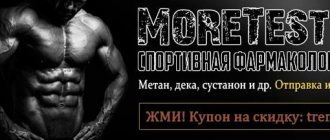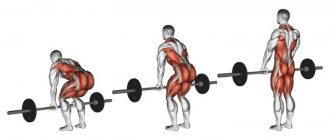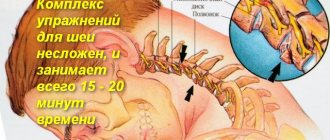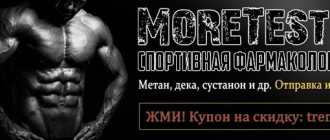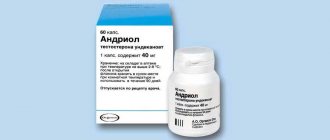Metabolism concept
Metabolism can be defined as a set of biochemical processes occurring in any living organism, including the human body. Metabolism is needed to ensure the vital functions of organs and systems, and these chemical reactions allow us to grow, adapt to environmental conditions, heal wounds, reproduce, etc. Metabolic processes are divided into two types:
- assimilation (constructive processes or anabolism);
- dissimilation (destructive processes or catabolism).
What is anabolism
Plastic exchange is possible only if there is a sufficient amount of energy. Anabolism is the process of formation of new cells, structures, tissues, organic substances in the body. The creation of particles is accompanied by the absorption of energy, while all processes occur at rest and are stimulated by anabolic hormones (steroids, insulin, growth hormone, etc.) Anabolism contributes to:
- muscle growth/development;
- bone mineralization;
- restoration of tissues and cells.
How to calculate your metabolic rate
Those calories that the body spends to ensure basic life functions are called metabolism or basal or basal metabolic rate. Basic functions require a fairly stable amount of energy, and these needs are not so easy to change. Basic metabolism takes up 60-70 percent of the calories a person burns every day.
It is worth noting that as you age, from about 30 years of age, your metabolic rate begins to slow down by 6% every decade. You can calculate the amount of energy your body requires at rest (BM, basal metabolism) in several stages:
- measure your height in centimeters;
- weigh yourself and record your own weight in kilograms;
- calculate BM using the formula.
For men and women, the formulas are different:
- for men, the metabolic rate is: 66+(13.7 x weight in kg) + (5 x height in cm) - (6.8 x age in years);
- for women, the metabolic rate is: 655 + (9.6 x weight in kg) + (1.8 x height in cm) - (4.7 x age in years).
So, for a 25-year-old man with a height of 177.8 cm and a weight of 81.7 kg, BMR = 1904.564.
Taking the obtained value as a basis, you can adjust it according to the degree of physical activity by multiplying it by the coefficient:
- for those who lead a sedentary lifestyle – 1.2;
- for those who go in for sports 1-2 times a week – 1.375;
- for those who play sports 3-5 times a week – 1.55;
- for those who play sports every day – 1.725;
- for those who spend all their time in the gym – 1.9.
In our example, the total daily cost for moderate activity will be 2952.0742 kcal. This is the amount of calories the body requires to maintain its weight at approximately the same level. To lose weight, calories should be reduced by 300-500 kcal.
In addition to basal metabolic rate, two other factors that determine daily caloric expenditure must be taken into account:
- processes of food thermogenesis associated with the digestion of food and its transportation. This is approximately 10% of the calories used in a day. This value is also stable and it is almost impossible to change it;
- Physical activity is the most easily modifiable factor affecting daily calorie expenditure.
What is catabolism
The stages of this process are carried out with the formation of energy (at the same time, ATP synthesis occurs in the ETC - the electron transport chain). Catabolism is energy exchange, the opposite of anabolism, which is characterized by the breakdown of tissues, organ structures, and complex substances into simple elements. The most important task of the process is to provide the body with the necessary energy and further use it for the needs of the body. Catabolism is caused by:
- stress;
- starvation;
- physical activity, other factors that are accompanied by the production of adrenaline.
The relationship between anabolism and catabolism
Both processes are interrelated and equally important for humans; they underlie metabolism. At the same time, energy metabolism serves as the basis for any biochemistry occurring in the body. Every life process will be impossible without metabolism: thanks to the transformation of energy and substances in the body, cells can grow, maintain their structure and develop, creating complex structures.
The relationship between anabolism and catabolism is undeniable, although the two processes are radically opposite to each other. As a result of catabolic reactions, energy and substances are produced that are necessary for the anabolic process. At the same time, anabolism ensures the production of enzymes and other products necessary for catabolism. For example, the human body can independently compensate for the lack of fourteen amino acids (constituent components of proteins). An imbalance of metabolic processes can lead to the death of the entire organism.
What happens during catabolism
With the help of energy exchange, the body obtains energy through the destruction of biological materials. During catabolism, the process of breaking down large complexes of molecules into smaller ones occurs, and the energy that is needed for the healthy functioning of organs and systems occurs. Thanks to catabolism, the body receives strength for any physical activity - from the cellular level to movement of the entire body. During catabolic reactions, large polymers are broken down into simple monomers - the building units from which they are formed. Example of catabolism:
- There is a violation of the integrity of nucleic acids responsible for the transmission of genetic information, as a result of which they break down into nucleotides. Nucleic acids are divided into pentose, purines, and pyrimidines.
- Polysaccharides are converted into monosaccharides through the process of catabolism. Substances (complex carbohydrates) such as cellulose, starch or glycogen belong to the group of polysaccharides. If they are destroyed, the body will receive simple or fast carbohydrates - ribose, glucose, fructose (a group of substances called monosaccharides).
- When proteins break down, amino acids are released. These substances, formed as a result of catabolism, can be reused in anabolic reactions, converted into other chemical compounds, or participate in the synthesis of other amino acids. Sometimes proteins break down into amino acids necessary for the synthesis of glucose that enters the blood.
Stages of catabolism
This process is necessary for the body to receive sufficient energy. Any substances processed in the human body are sources of ATP - special molecules necessary for energy storage. The amount of adenosine triphosphate is limited, so it must be constantly replenished and this can only be done through catabolism. Energy exchange occurs in several stages. Stages of catabolism:
- carbohydrates, proteins, fats break down into simple molecules in the gastrointestinal tract, outside the cell;
- molecules enter the cell, resulting in energy accumulation (oxygen-free stage);
- The catabolic processes are completed with the formation of carbon dioxide, large amounts of energy and water.
Examples of anabolic processes
Protein synthesis
Proteins are macromolecules that carry out cellular activities encoded by the body's genes. They have many different functions in the body, including replicating DNA, assisting chemical reactions (in the form of enzymes), transporting substances into the cell, growing and signaling within the cell, and providing physical structure. Each cell in the human body contains from 1 to 3 billion proteins.
Proteins are synthesized from smaller molecules called amino acids in the cell's ribosomes. Each protein is a chain of a specific sequence of amino acids. Since proteins are larger molecules made up of smaller ones, the process of protein synthesis is anabolic.
DNA synthesis
Deoxyribonucleic acid, or DNA, is the genetic material of an organism. this macromolecule is made up of smaller molecules called nucleic acids, which themselves consist of a nucleotide base attached to a deoxyribose sugar and a phosphate molecule. DNA synthesis is an anabolic process that occurs in the cell nucleus just before the cell divides. It involves unzipping double strands of DNA and adding new matching nucleotides to each half of the unzipped strand, forming two new strands, each containing half of the old DNA strand.
Growth of bones and muscles
On a larger scale, growth of body parts such as bones and muscles is anabolic. Bone growth or ossification occurs when bone is formed from cells called osteoclasts. It is then mineralized through cells called osteoblasts. This process is also anabolic; During mineralization, osteoblasts produce calcium phosphate crystals, which are incorporated into the bone structure, making the bones hard and strong.
muscle Growth, also called muscle hypertrophy, occurs when skeletal muscle cells called myocytes increase in size. This happens through strength training such as weight lifting. Factors such as gender, age and diet influence hypertrophy. During hypertrophy, the synthesis of actin and myosin proteins increases, and the volume of sarcoplasmic fluid in the myocyte increases.
What happens during the process of anabolism
During energy exchange, matter is created and energy is consumed. As a result of anabolic reactions, complex substances are created. During anabolism, new cells are created and homeostasis of all living tissues of the body is maintained. The body's action is aimed at creating more complex molecules from simple units. The mechanism of anabolic reactions is characterized by the use of several simple substances to synthesize many different end products. Examples of anabolic effects are:
- nutrition of bone tissue for their growth, restoration, development;
- increase in muscle mass;
- wound healing;
- growth of nails, hair, etc.
Due to anabolic processes, monomers are converted into polymers - large molecules with a complex structure, including many miniature building units that are similar to each other. For example: amino acids (monomers) as a result of a series of anabolic chemical reactions form proteins, which are large complex molecules with a three-dimensional structure (polymers).
The meaning of anabolism and catabolism
Energy metabolic reactions play a very important role for humans, and the body can maintain its normal state only if anabolism and catabolism are in balance. When one of the bioprocesses is suppressed, a violation of the second is inevitable, since they are closely related. An imbalance of energy metabolism can cause various diseases, hormonal imbalances and, as a result, a strong gain of fat, or the reverse process will start and excessive weight loss will occur.
Catabolism is responsible for breaking down muscle tissue and other elements to produce energy. The reaction is triggered during stress, poor sleep, sports training, fatigue, hunger. At the same time, the body produces the hormone cortisol, which destroys muscles, thereby activating the accumulation of fat and increasing glucose levels. These phenomena are extremely undesirable for athletes. However, cortisol also has a positive effect on the body: it breaks down muscle amino acids, which is extremely important for human life.
The importance of anabolism and catabolism for human life cannot be overestimated. If you try to artificially suppress catabolic reactions, hormonal imbalances are likely to develop, so you should learn to adhere to the correct daily routine and control muscle development. This can be achieved if you provide your body with proper rest, lead a healthy lifestyle, choose a balanced diet and competently create a training program. In addition, experts advise athletes to use dietary supplements and vitamins.
Amino acid pool, transport and oxidation of amino acids
As noted earlier, muscle tissue serves as the largest “storage” of amino acids in the body, as well as large amounts of protein. There are 2 main amino acid pools that we are currently interested in - circulating and intracellular.
When the body is in a state of fasting (and other catabolic states), amino acids are released from the muscles into the bloodstream to nourish the rest of the body's tissues. Conversely, when protein anabolism is necessary, amino acids are actively transported from the bloodstream into the intercellular space of muscle cells and are incorporated into proteins (thus synthesizing new ones).
That is, in addition to intracellular amino acids, protein synthesis/anabolism is also partially regulated by the transport of amino acids both into and out of muscle cells.
In animals (mostly carnivores), amino acids provide sufficient energy through oxidation. The oxidation of amino acids to ammonia, followed by the formation of a carbon skeleton, occurs with excessive protein in the diet, fasting, carbohydrate restriction and/or diabetes.
Ammonia is excreted from the body as urea through the kidneys, while the carbon skeletons of amino acids enter the citric acid cycle to produce energy. Some people argue against the traditional "bodybuilder diet" and argue that high protein intake puts stress on the kidneys. However, even consuming more than 4 grams of protein per kilogram of lean body mass does not pose any risk for people with healthy kidneys (although this is an excessive amount for most natural athletes).
“Estrogen increases growth hormone and IGF-1 levels, which is beneficial for protein anabolism and anti-catabolism”
Insulin
Insulin is a peptide hormone produced by the pancreas, mainly in response to increased blood sugar levels (since it acts as a regulator of glucose transporter proteins).
With the sharp increase in the incidence of type 2 diabetes in the United States, insulin, unfortunately, has become notorious as almost the main enemy of humanity. However, if your goal is to create a lean and muscular body, then insulin will serve you well. Take advantage of its anabolic properties, and do not avoid it at all costs, as many opponents of carbohydrates suggest doing.
Insulin is one of the most powerful anabolic hormones in the human body. It activates protein synthesis throughout the body with sufficient amino acid replenishment. The key point here is that a state of hyperinsulinemia (increased insulin levels) without the concomitant presence of amino acids does not lead to an increase in protein synthesis throughout the body (although it does reduce the rate of protein breakdown).
Additionally, while insulin reduces protein breakdown throughout the body, it does not modulate the ubiquitination system responsible for regulating muscle protein breakdown.
Research shows that insulin does not directly alter the rate of transmembrane transport of most amino acids, but rather increases muscle protein synthesis based on the active intracellular pool of amino acids. The exception to this rule are amino acids that use the sodium-potassium pump (primarily alanine, leucine, and lysine) because insulin causes skeletal muscle cells to hyperpolarize by activating these pumps.
This suggests that a state of hyperinsulinemia in parallel with a state of hyperaminoacidemia (increased plasma amino acid levels) should be sufficiently favorable for muscle protein synthesis. This is why patients with extreme malnutrition are often given injections of amino acids and insulin.
Summary:
Insulin is an anabolic hormone that promotes protein synthesis in skeletal muscle, but requires a supply of amino acids to achieve this effect.
As noted above, states of hyperinsulinemia and hyperaminoacidemia will promote muscle protein synthesis, and the best way to induce them is to simply consume protein and carbohydrates.
However, you should not assume that the more insulin, the better. Research shows that although this hormone increases protein synthesis in muscles after eating, there is a certain saturation point when it no longer provides a more intense response.
Many people find that a huge serving of fast carbohydrates along with whey protein is ideal for activating muscle protein growth, especially after strength training. In fact, you shouldn't try to spike your insulin levels. A slow, gradual insulin response (as seen with low-glycemic carbohydrate loading) provides the same benefits for muscle protein synthesis as a fast one.
Insulin-like growth factor-1 (IGF-1) and insulin-like growth factor binding protein-3 (IGFBP-3)
IGF-1 is a peptide hormone, very similar in its molecular structure to insulin, which affects the growth of the body. It is produced mainly in the liver when growth hormone binds and acts on some tissues both locally (paracrine) and systemically (endocrine). Thus, IGF-1 is a mediator of the influence of growth hormone and affects cell growth and proliferation.
It is also important to consider the action of IGFBP-3 in this context, since virtually all IGF-1 is bound to one of 6 protein classes, and IGFBP-3 accounts for about 80% of all these bindings.
IGF-1 is thought to have effects on protein metabolism similar to insulin (at high concentrations) due to its ability to bind and activate insulin receptors, although to a much lesser extent (about 1/10th the effect of insulin).
It is therefore not surprising that IGF-1 promotes protein anabolism in skeletal muscle and the body as a whole. A unique feature of IGFBP-3 is that it inhibits skeletal muscle atrophy (i.e., has an anti-catabolic effect).
Summary:
Since IGF-1 and IGFBP-3 stimulate protein anabolism and prevent skeletal muscle wasting and cachexia, many of you may have a reasonable question about how to increase blood levels of these structures?
Well, the amount of IGF-1 and IGFBP-3 (as well as growth hormone) in the blood at any given time is influenced by several factors, including genetics, biorhythms, age, exercise, diet, stress, disease and ethnicity.
Many may assume that an increase in insulin levels will lead to a subsequent increase in IGF-1, but this is not the case (let me remind you - insulin and IGF-1 are structurally somewhat similar, but are produced differently). Since IGF-1 is ultimately produced by growth hormone (approximately 6-8 hours after it enters the bloodstream), it is wiser to focus on increasing levels of the latter (which we will discuss in the section on growth hormone).
And one more note. In recent years, some supplement manufacturers have tried to convince us that deer antler extract promotes skeletal muscle growth and recovery due to the high amount of IGF-1 it contains. You should not believe these words because IGF-1 is a peptide hormone, and if taken orally, it will be quickly broken down in the gastrointestinal tract before entering the bloodstream. It is for this reason that people with type 2 diabetes are forced to inject insulin (also a peptide hormone) rather than take it in tablets or other similar forms.
“Cortisol is often involved in the process of muscle wasting because it primarily acts as a catabolic hormone in terms of its metabolic functions.”
A growth hormone
Growth hormone (GH) is a peptide hormone produced by the pituitary gland that stimulates cell growth and reproduction. If a person eats a good diet, GH triggers the production of insulin in the pancreas, as well as IGF-1 once it reaches the liver, which subsequently leads to an increase in muscle mass, fat tissue and replenishment of glucose stores. During fasting and other catabolic states, GH preferentially stimulates the release and oxidation of free fatty acids for use as an energy source, thereby preserving lean body mass and glycogen stores.
Many fitness gurus misunderstand the effects of GH, claiming that it is not an anabolic or has any medical benefits (which sounds presumptuous, given the body of scientific evidence regarding this hormone). In fact, GH has a number of anabolic actions, but these are different from the actions of insulin. GH can be considered as the main anabolic hormone during stress and fasting, while insulin is such during the preprandial period.
Summary:
GH is a very complex hormone that is being actively studied by scientists today, since many of its properties remain unclear.
GH is a powerful hormone that stimulates protein synthesis and reduces protein breakdown throughout the body. It is likely that these effects can be induced in skeletal muscle tissue, as well as by increasing IGF-1 levels (I hope that research will focus on this aspect in the coming years).
In addition, GH strongly inhibits the oxidation process and enhances the transmembrane transport of important amino acids such as leucine, isoleucine and valine (branched chain). It should also be noted that GH is a major factor in fat burning because it promotes the use of free fatty acids as an energy source.
As noted above in the section on IGF-1, the volume and timing of GH secretion is influenced by many variables. If we take into account that GH is secreted in a “pulse” mode (about 50% of the total daily production occurs during deep sleep), then it is advisable to consider the following list of its stimulants and inhibitors:
GH production stimulants:
- Sex hormones (androgens and estrogens)
- Peptide hormones such as ghrelin and growth hormone releasing peptides (GHRH)
- L-DOPA, a precursor to the neurotransmitter dopamine
- Nicotinic acid (vitamin B3)
- Nicotinic receptor agonists
- Somatostatin inhibitors
- Hunger
- Deep dream
- Intense exercise
GH production inhibitors:
- Somatostatin
- Hyperglycemia
- IGF-1 and GR
- Xenobiotics
- Glucocorticoids
- Some sex hormone metabolites, such as dihydrotestosterone (DHT)
“The idea of building muscle and burning fat at the same time is best thought of as a see-saw (board on a stand) – if one side goes up, the other is bound to go down.”
Androgenic hormones
Many of you are probably familiar with the term “anabolic androgenic steroids” (AAS), often used in the media and fitness community. Androgens are indeed anabolic hormones that influence the development of male reproductive organs and secondary sexual characteristics.
There are several androgens produced in the adrenal glands, but we will focus only on testosterone (it is mainly produced in the testes of men and the ovaries in women), since it is the main male sex hormone and the most powerful natural, endogenously produced anabolic steroid.
There is ample evidence that testosterone plays a key role in the growth and maintenance of skeletal muscle tissue. Studies have shown that taking testosterone-based drugs by men with hypogonadism causes a fairly dramatic increase in muscle tissue, skeletal muscle strength and protein synthesis. A similar effect was achieved in athletes and ordinary healthy people after administering pharmacological doses of various androgens.
It appears that testosterone, like growth hormone, has an anabolic effect by reducing the oxidation of amino acids (particularly leucine) and increasing their uptake into the body as a whole, as well as into skeletal muscle proteins.
In addition, testosterone and growth hormone create a synergistic anabolic effect, enhancing their effects on protein synthesis in skeletal muscles.
Summary:
There are many reasons why testosterone and other androgens have been so well studied. It is clear that these compounds have numerous anabolic properties. Testosterone is a strong inhibitor of amino acid oxidation and increases protein synthesis, both in skeletal muscle and in the body as a whole (and also appears to have an anti-proteolytic effect). As with growth hormone and IGF-1, multiple factors play a role in modulating endogenous testosterone secretion. Below is a short list of some of them.
Positive factors:
- Getting enough sleep
- Reduced fat levels (to a certain extent, as fat cells secrete aromatase)
- Intense exercise (especially strength training)
- d-Aspartic Acid Supplements
- Vitamin D supplements
- Abstinence (for approximately 1 week)
Negative factors:
- Obesity
- Lack of sleep
- Diabetes mellitus (especially type 2)
- Sedentary lifestyle
- Extremely low calorie diet
- Long-term aerobic/cardio exercise
- Excessive alcohol consumption
- Xenobiotics
Estrogen hormones
Estrogens are the main female sex hormones that are responsible for the growth and maturation of reproductive tissues. They are also present in the body of men, although in much lower concentrations. There are three main estrogens produced during steroidogenesis: estradiol, estrone and estriol. In terms of its effects, estradiol is approximately 10 times more powerful than estrone and 80 times more powerful than estriol.
In women, most estrogen is produced in the ovaries through the aromatization of androstenedione, while in men, small amounts are produced in the testes as a result of the aromatization of testosterone in fat cells.
Unlike those hormones we have already discussed, estrogens seem to have both anabolic and catabolic properties in relation to protein metabolism (mainly through other hormones in the body).
Studies have shown that estrogens increase GH and IGF-1 levels, both of which are beneficial for protein anabolism and anti-catabolism. In addition, estrogens retain water, which promotes cell enlargement and therefore the anabolic process.
However, when present in excess, estrogens can indirectly cause catabolism by blocking androgen receptors and down-regulating gonadotropin-releasing hormone production in the hypothalamus, which ultimately leads to decreased testosterone production in the body.
Summary:
As with all things health and fitness, a balance must be found in your estrogen levels. Estrogens play many important roles in the human body, including a number of anabolic/anti-catabolic effects on protein metabolism.
Be careful as excess estrogen levels (especially in men) usually result in decreased testosterone secretion and availability, preventing its positive effects on protein metabolism.
Here are some general tips to help you balance your estrogen production:
- Eat a balanced diet with enough vitamins, minerals and fiber
- Limit your intake of soy and phytoestrogens from plant foods
- Limit alcohol consumption as it impairs the liver's ability to metabolize estrogens
- Exercise regularly
- Maintain a healthy body weight, avoiding underweight or obesity
Thyroid hormones
Thyroid hormones are one of the main regulators of metabolism, affecting almost every cell of the human body. The thyroid gland produces thyroxine (T4) and triiodothyronine (T3), with T4 being a prohormone of T3. T3 is approximately 20 times more potent than T4 and is therefore considered the “true” thyroid hormone (most T3 is formed by deiodination of T4).
Research evidence suggests that thyroid hormones increase both protein synthesis and breakdown throughout the body. At the same time, they stimulate the latter more actively, which means they have a catabolic effect.
In general, thyroid hormones, in the normal physiological range, play a major role in the regulation of protein metabolism. There appears to be no benefit to skeletal muscle or protein anabolism in increasing thyroid hormone production to achieve a state of hyperthyroidism, which likely has a catabolic effect.
Summary:
Since the main purpose of this article is to talk about hormones and factors affecting protein metabolism, this section did not mention the role of thyroid hormones in the process of fat and carbohydrate metabolism. Just know that the catabolic nature of thyroid hormones means they will be beneficial for fat loss by upregulating metabolism (which is why many people with hyperthyroidism tend to be underweight and/or have difficulty gaining weight).
However, if your goal is to achieve anabolism (especially in skeletal muscle), you should not manipulate thyroid hormone levels. The best solution for you to maintain proper protein metabolism is to maintain a euthyroid state (that is, normal).
How to increase anabolism
Only with a balance of anabolism and catabolism will proper metabolism and a healthy state of a person be ensured. Excessive predominance of one process over another causes the development of various pathologies, so you should consult a doctor before deciding to increase anabolism. You can make the energy exchange rate high in the following ways:
- Diet. An increase in the amount of protein consumed leads to a natural increase in the volume of building materials for muscles. However, excess protein will not be as beneficial if you eat low-calorie foods, since the body will not have enough energy to absorb it. Nutrition must be balanced, then the cells will receive the necessary building material faster and muscle tissue will begin to grow.
- Dream. Adequate rest is very important for anabolism, especially if a person was involved in sports that day.
- Diet. Without the timely supply of nutrients to the body, the process of tissue growth is impossible.
- Mental stability. To reduce the rate of catabolic reactions, it is important to avoid stressful situations.
- Taking doping drugs. This measure is extremely undesirable for accelerating anabolism, since it often leads to problems at the hormonal level and other pathologies.
Diet and nutrition
Accounting for caloric intake
Keeping track of the number of calories you consume every day is very important for managing your weight, especially if you want to lose weight.
Severe caloric restriction has been proven to be ineffective in the long term. An extreme reduction in caloric intake can force the body to rebuild its metabolism so that much less energy is consumed, and any energy source will be immediately stored in adipose tissue. Low-calorie diets often have a negative impact on motivation, leading to overeating after quitting the diet.
Unless your extremely low-calorie diet was developed by a qualified dietitian, nutritionist or medical professional, you are at risk of malnutrition, which not only harms your health, but also changes the course of your metabolic processes in such a way that it will be even more difficult for you to achieve your goal.
Of those who went on extreme diets, the lion's share are still obese, and only a few have managed to return to normal body weight.
Anabolism and catabolism in sports
Since physical activity is a serious stress for the body, it triggers catabolic processes. Training creates the need to look for additional sources of energy (the body takes them not only from fat deposits, but also from proteins - the building blocks of muscles). What is muscle catabolism? This is a natural process in which the energy required for physical effort is produced through the breakdown of muscle tissue.
Anabolism and catabolism in sports is always a hot topic, since it is important for athletes to maintain maximum or even increase muscle volume. One of the main tasks of a person of any age who is actively involved in sports is to weaken the catabolic reactions of proteins and activate the anabolic process. A bodybuilder can balance anabolism and catabolism with proper nutrition, adherence to a rest regime and taking sports supplements (protein, etc.).




